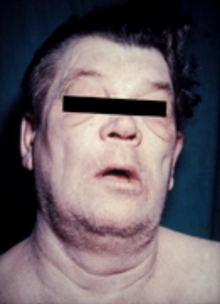Coma myxœdémateux
coma, complication rare de l'hypothyroïdie
Le coma myxœdémateux est une complication rare mais grave de l'hypothyroïdie[1],[2],[3]. C'est un coma calme, hypothermique avec bradycardie.

Il est déclenché par une infection, un traumatisme, une intervention chirurgicale ou un arrêt du traitement substitutif. Le pronostic est dominé par plusieurs manifestations respiratoires : bradypnée, encombrement bronchique, épanchements pleuraux. Le pronostic est sombre malgré un traitement prudent par des hormones de substitution utilisées par voie parentérale.
Causes
modifierPathophysiologie
modifierDiagnostic
modifierNotes et références
modifier- (en) Cristen Rhodes Wall, « Myxedema Coma: Diagnosis and Treatment », American Family Physician, vol. 62, no 11, , p. 2485–2490 (ISSN 0002-838X, PMID 11130234, lire en ligne)
- (en) Vivek Mathew, Raiz Ahmad Misgar, Sujoy Ghosh, Pradip Mukhopadhyay, Pradip Roychowdhury, Kaushik Pandit, Satinath Mukhopadhyay et Subhankar Chowdhury, « Myxedema Coma: A New Look into an Old Crisis », Journal of Thyroid Research, vol. 2011, , p. 493462 (PMID 21941682, PMCID 3175396, DOI 10.4061/2011/493462)
- (en) Ghada Elshimy et Ricardo Correa, « Myxedema », sur StatPearls, StatPearls Publishing, (PMID 31424777)